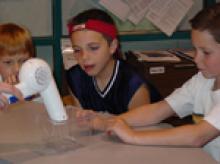
The goal of this demonstration is to demonstrate and explain Nitinol's shape memory properties.
Nitinol Procedure
Materials needed:
- 2 or more pieces of Nitinol
- Hair dryer
- Clear container
Procedure
Set-up:
- Check to make sure you have all the supplies.
- Make sure the Nitinol is in its original shape, whether straight or spring. Use the blow dryer to reset it if it is not.
The Demonstration:
- Hand pieces of Nitinol to visitors. Tell them that this wire is made of a material called Nitinol [pronounced night-in-all] and is a mixture of nickel and titanium. Its name comes from Nickel, Titanium, and the Naval Ordnance Laboratory, where it was discovered during the 1960s. Tell them that the wire's other name is memory metal. Ask why they think it might be called memory metal.
- Ask visitors to bend the wire. Then ask them to try to put it back exactly in its original shape.
- Ask visitors if there is any way to get the wire exactly back in shape. Ask them if they think a blow dryer could help. Explain that you will raise the temperature of the wire using the hair dryer. Put the wire in the container so it doesn't blow away. Use the blow dryer to reset the shape of the Nitinol. Make sure all the visitors can see.
- Let the wire cool so it will be safe for visitors to touch. Then repeat the demonstration, allowing visitors to use the hair dryer.
- Explain that Nitinol is a smart material that remembers its shape, and that, when heated above a certain temperature called its transition temperature, it will always bounce back to its original shape. For more information, see Nitinol FAQ sheet.
Cleanup:
- Make sure the Nitinol is in its original shape. Use the blow dryer if it is not.
- Gather all materials and return to storage.
Procedure Sheet: nitinol_procedure.pdf
Nitinol FAQs
Nitinol is a shape memory alloy, a mixture of two types of metal (in this case nickel and titanium) that will bend but will return to its original shape when heated.
Cool Facts:
- Nitinol stands for Ni ckel, Ti tanium, and the N aval O rdnance L aboratory, where it was invented in the 1960's.
- This metal has two states. When cool, Nitinol is in a bendable state and is very soft. At higher temperatures, it is in its rigid state and very springy.
- At a certain temperature, called the transition temperature, Nitinol changes from its bendable state to its rigid state, "remembering" the original shape (see training).
- This metal has been used to make trick spoons. The spoons are straight until placed in a cup of hot chocolate (coffee, tea, etc.), then they quickly bend in half, surprising the user!
- Nitinol has many other cool properties, such as superelasticity which making more "springy" springs, and "unbreakable" glasses frames. (See Q&A for explanation.)
A: Yes! If you keep heating Nitinol above the transition temperature, it will reach a second transition temperature (usually around 500 °C!) where it can be bent, or trained permanently.
A: Right now, this material is too expensive to use in large quantities. However, as the technology used to make Nitinol advances, the price will decrease.
A: It varies. By changing the composition of the metal (by changing the Ni/Ti ratio or with additives), the Nitinol can be "tuned" to a certain transition temperature: anywhere from – 140 ºC (as cold as winter on Mars' poles) to 75 ºC (as hot as a cooked chicken out of the oven).
A: When the metal is very close to the transition temperature, applying force is enough to change some atoms of the metal from one state to the other, bending the wire. When you let go (force is removed), the metal goes back to the rigid state, remembering its shape.
Nitinol's shape memory has found use in many appliances as a switch that responds to either heat or electric current. Orthodontists use Nitinol as the wires for braces. In a person's mouth, the Nitinol warms, changes shape, and pushes on the teeth. This is less painful than steel wires, and allows for more time between orthodontist appointments. Super elasticity gives us "unbreakable" eye glasses frames and fish hooks, because the metal bends rather than breaking.

